|
|
Sir Peter Teazle

|
|
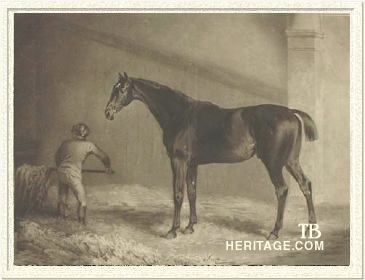 |
|
|
Sir Peter Teazle was a brown horse bred in 1784 by the Earl of Derby, from "...whom no amount of money could have purchased [Sir Peter Teazle]." He was an outstanding race horse, and even more important in the stud, responsible for carrying the speed and stamina of Herod sire line forward through his successful offspring. His older contemporary at stud was Pot-8-Os (Eclipse line), and the comparative success of their youngsters was often debated. Like Pot-8-Os, and Pot-8-Os' son, Waxy, he produced some important sire sons, which kept the debate alive for years.
His sire, Highflyer, was undefeated on the turf, and in Richard Tattersall's stud became the most influential stallion of his era, leading the sire's list sixteen times, getting 469 winners, including seven classic winners. Several of Highflyer's sons were good sires, but it was Sir Peter who continued the sire line through his son, Walton. He also got an extremely influential matron, Prunella, the source of much of the female Family #1's success, and a number of other daughters of significance.
Sir Peter's dam was Papillon (1769), by (Old) Snap, a four-time leading sire, credited with introducing speed into the breed. Papillon was a moderately successful race mare that ran for William Henry Fortescue, the first Earl of Clermont. One of her best races was a third to Firetail and Miss Timms in Newmarket's 1773 Craven Stakes, beating twenty-two other horses. In the stud of Lord Grosvenor, and then in the Earl of Derby's stud, she produced twelve live foals, of which Sir Peter was her seventh, many of them winners, including Sir Peter's sister, Lady Teazle (1781), winner of eleven races, and second in the Oaks to Stella.
Sir Peter's breeder and owner was Edward Smith Stanley, the 12th Earl of Derby (1752-1834). It was at one of his estates, the Oaks, near Epsom, that the Oaks and Derby stakes were first planned by the earl and his sporting associates, and although cockfighting was his passion, he was a lifelong supporter and participant in turf matters. The Oaks was the setting for many lavish parties, including one celebrating his marriage to the beautiful Elizabeth Hamilton; he and his affianced came dressed as a Vandyke painting, and strolled amidst imported orange trees and straw-colored satin "haycocks." It was the social event of the season. It was at these house parties that the idea for two premier classic horse racing events was hatched, first with the idea of a sweepstakes for three-year-old fillies over a mile and a half, patterned on the successful race at Doncaster, the St. Leger, which had been established two years earlier, in which a "dash," rather than heats, would determine the winner. In the first running of the fillies race at the Oaks in 1779, Derby's filly Bridget beat twelve others.
The elite group of turfites deemed the Oaks fillies race a success and it was agreed that it would be renewed the following year, along with another race for three-year-old colts and fillies; the oft-told story tells us that Sir Charles Bunbury, "perpetual president" of the Jockey Club and the earl flipped a coin to determine the name of the race. The first "Derby" then, was held in May of 1780, won by Bunbury's colt, Diomed. In all his long association with the turf, the earl only once won the race that carried his title, with Sir Peter Teazle. Later, a Sir Peter daughter, Hermione, would win the Oaks, the earl's third, and last, classic winner.
Not more than a couple of years after their marriage, the earl's wife, Elizabeth, eloped with the Duke of Dorset. While he refused her a divorce, the earl soon took up with the actress Elizabeth Farren, whom he married much later. Sir Peter Teazle and his sister, Lady Teazle, were named in recognition of Farren's role as Lady Teazle in Sheridan's The School for Scandal.
Sir Peter on the Turf
He debuted on the track at age three in the Derby Stakes at Epsom, which he won. That year he also won a sweepstakes at Ascot, the 1,000 Guineas subscription race for three-year-olds and the Prince of Wales's Plate at the first Newmarket October meeting. At the second October meeting at Newmarket he beat the Woodpecker colt, Bullfinch, in a 500 guineas match "Across the Flat," and later in the same meeting received a compromise forfeit from Bullfinch in a second 300 guineas match. Also in that meeting he won a 140 guineas subscription purse, and took a walk over for a sweepstakes. He retired for the season undefeated.
At age four at Newmarket First Spring he won the Jockey Stakes, the rich Claret Stakes, and the Fortescue Stakes, twice beating Buzzard, and received a compromise in a scheduled match against Mentor. At Newmarket July he won the Grosvenor Stakes over two miles. In October at Newmarket he received a forfeit in a 700 guineas match against Mentor. He then suffered his first defeat, in a 500 guineas match against the Duke of Queensberry's four-year-old Florizel colt, Dash, giving Dash 32 pounds in weight; Sir Peter had had to stop training several days before the race because he had "got pricked in shoeing." His final race of the year was a 300 guineas match against the good mare Maria (by Telemachus), which he won. He was seven for eight that season, his only loss one in which he was conceding gobs of weight.
In 1789 he came out at Newmarket Craven and won 425 guineas, beating one of Eclipse's better sons, Meteor, and two others. At Newmarket First spring, he was engaged for a six mile, 1,000 guineas match against Dash, which he forfeited, and likewise a 500 guineas match at even weights against Meteor, also forfeited, most likely an indication all was not well with him. He raced again at Newmarket October, and over the Beacon course was beaten by the Florizel son, Mulberry, conceding 28 pounds to Mulberry. At the same meeting he broke down running for a purse, and was retired to Derby's Knowsley Stud in Lancashire.
Sir Peter in the Stud
Sir Peter threw a number of important youngsters, many of them his same "rich brown color." Among them were the stout Sir Solomon, who won "the finest four-mile race ever run at Doncaster," and Stamford, twice winner of the Doncaster Cup; four Epsom Derby winners--Sir Harry (in 1798), Archduke (1799) Ditto (1803) and Paris (1806). His slightly younger contemporary, the Pot-8-Os son Waxy, who, like Sir Peter Teazle, was a Derby winner, also sired four Derby winners. Sir Peter also sired the Oaks winners Hermione (1794), and Parisot (1796), and four St. Leger winners, Ambrosio (1796), Fyldener (1806), Paulina (1807) and Petronius (1808). He was champion sire in Great Britain nine times between 1799 and 1809, his successive sojurn at the top of the list broken only once during those years, by Trumpator in 1803.
As a sire of sires, he was highly successful, getting four good stallions in England, Sir Paul, Walton (twice leading sire), Haphazard (sire of the good race horse and one-time leading sire, Filho da Puta), and Stamford, an influential broodmare sire. Sir Peter's son, Sir Harry, was imported into Virginia, where he was the leading sire in the U.S. for several years, and is seen in today's pedigrees through his daughters.
|
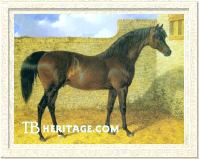
Walton
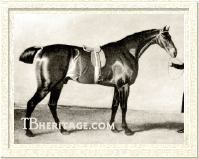
Sir Harry
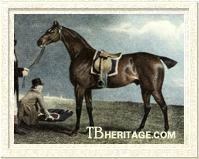
Haphazard
| |
WALTON, out of Arethusa, the daughter of an Eclipse son, Dungannon, was a good distance horse, winner of several king's plates, matches, and Newmarket's Oatlands Handicap. He got Derby winner Phantom, later a leading sire; St. Leger winner St. Patrick; Two Thousand Guineas winner Nectar; Rainbow, an important sire in France, and Partisan, a good runner who sent the main branch of the Sir Peter sire line forward through his sons, Venison, Gladiator, and Glaucus. Walton was twice leading sire in Great Britain.
SIR HARRY, out of the Alfred mare, Matron, was a Derby winner. He made one season in England before being sold to William Haxall of Petersberg, Virginia for the highest price ever paid to that date for a horse imported into America. In England he left a great runner in his daughter Medora, winner of the Oaks and other races, who in the stud produced another Oaks winner, Gulnare. In the U.S. Sir Harry was a successful sire of distance runners, and was the leading sire there before Sir Archy's offspring began to dominate the American turf. His U.S. offspring included two useful stallions, Haxall's Moses (1816) and Sir Alfred (1806).
HAPHAZARD (1775), an outstanding distance horse and "a gay nag-looking horse with a low back, and very fine action," was the third Sir Peter son to continue the sire line in any meaningful way. He was another brown colt, and another that took advantage of the Eclipse cross, his dam, Miss Hervey, being a daughter of Eclipse, who had produced a good runner by Highflying in King David (1783), and also produced an UNNAMED sister to Haphazard (1798). The GSB reports she was shot in 1804, age 29, after which it was discovered she was carrying a Sir Peter colt, which must have disturbed her owner, the Earl of Darlington. The SISTER TO HAPHAZARD bred on, with the good Castrel son, Bustard (1813) and the French sire and race horse Consul (1866, Prix du Jockey Club) among her tail-female descendants.
|
Haphazard ran in the colors of the earl, whose stud was located at Raby Castle, Co. Durham, and so he raced almost exclusively in the north of England. His first and only race at age three was the (then) four mile Doncaster Cup, placing second to the five year old Dion. The next year he won six of his seven races at distances of two to four miles, at Catterick, Preson, Kuntsford, Pontefract, Doncaster, and Carlisle, his only loss was the Richmond Cup, won by AGONISTES (1797, by Sir Peter, from Woodpecker daughter Wren), also owned by the earl.
At age five he he again won six of his seven races, all over 4 miles, including the Doncaster Stakes, the Great Subscription Purse at York, and a King's Plate at Carlisle; his only loss was the Richmond Cup, again, in which he ran third. The next year (1803) he was unbeaten, winning three races at York, including a match against a Walnut son, a 200 guineas race over 4 miles, and the Great Subscription Purse; he also, in his sole venture south, he received a compromise from another great distance horse and important sire, Dick Andrews, in a scheduled 500 guineas match at Newmarket. He won the Great Subscription Purse for the third time in 1804, and also beat the good runner Traveller (by Highflyer) in a 200 guineas match. He ran once more in 1806, age nine, beaten by Dick Andrews in the Ladies' Purse at Lewes.
His son, Filho-da-Puta (1812), a big (16 hand), handsome brown horse, won the St. Leger, the Doncaster Cup, and a number of Cups and stakes over four miles, although he lost one of the celebrated matches of the early 19th century against Sir Joshua. A champion sire in 1828, Filho got two two good sons, the in-bred Colwick (out of a SIR OLIVER daughter) and St. Leger winner Birmingham, and Colwick got a beautiful, fast son in Attica (1839), a winner of the Derby. In addition to Filho, Haphazard got two Two Thousand Guineas winners, Antar (in 1819) and Reginald (1821), and Reginald's sister Rowena, winner of the One Thousand Guineas. His son, Figaro, was a Doncaster Cup winner.
STAMFORD (1794, out of another Eclipse daughter, Horatia) was also a good sire, although his influence was through his excellent producing daughters. Unlike many other Sir Peters, that were large and heavy, he was a small, compact horse with a great deal of quality about him, but true to his sire line, he was another youngster that excelled at a distance.
He won eleven races, including the Doncaster Cup, which he won twice, in 1798 and 1798. He ran second in the St. Leger of 1797, and in a terrible six-heat race over 2 miles at Doncaster that year, he won the first heat, but did not succeed in the following heats, finally won by Warter, with Pepperpot second, and Stamford third, with four others unplaced. In his four years on the turf, he ran both in the northa nd the south. In 1798, he was second to AMBROSIO in Newmarket's Oatlands handicap stakes, and the following year second to Diamond in Newmarket's Jockey Club Plate. His wins included King's Plates at York.
Stamford became an exceptional broodmare sire. His daughter, Lady Rachel (1805), produced one of the best race mares of the first half of the nineteenth century, Fleur-de-Lis (1822, by Bourbon), who ran for seven seasons, winning twenty races and out of the placings just twice in her long career, in which she met and bested the top horses, male and female, of her time. Her many wins included the Doncaster Stakes (twice), the Doncaster Cup (she also ran second and third in that race), the Goodwood Cup (twice), the Oatlands handicap stakes, Epsom's Craven Stakes, and many prestigious cups over four miles. Lady Rachel's female line bred on.
Emily (1810) was the dam of Emilia (1823, by Abjer), responsible for a good female branch of Family 28, and of Emilia's brother, Derby winner Emilius, who was undefeated at age three and in the stud became a two-time leading sire in Great Britain, with winners of eight classic races to his credit. Emily's sister, Diana (1808), was the dam of Actaeon (1822, by Scud), a good north country runner and winner of the Richmond Cup, later a moderately successful sire.
Stamford's daughter Miss Cantley (1812, out of a mare by Mercury) became the dam of the fast, high-strung Beiram (1829, by Sultan), winner of the July and Prendergast Stakes at age two, and at age three of the Goodwood Drawing Rooms Stakes, and second to Priam in the Goodwood Cup. She also produced Beiram's sister, Mecca, winner of the July Stakes and Ascot's Gold Vase, who produced St. James's Palace Stakes winner Nutcracker.
Miss Cantley's sister, Belvoirina (1813, by Stamford), a winner of the July Stakes and two other races at Newmarket, became an important foundation mare in Family 5 - c, with horses such as Doncaster, Dutch Skater, Oaks winner Refraction, and many other horses too numerous to mention decending from her. Belvoirina's daughter, the in-bred Maria (1824), by Waterloo (by Sir Peter son Walton), was an outstanding winner and speedster, undefeated at age two, winner of four out of six starts at age three, including Ascot's Swinley Stakes and the Windsor Forest Stakes the next day. At age four she won four out of five races, having fallen in the King's Plate race she did not win, and at age five she won a 500 guineas match beating the good horse Souvenir.
An unnamed Stamford mare (1803) produced Doncaster Cup winer Trophonius. Stamford's daughter Miss Sophia produced Richard (1818) and Master Henry (1815) to the cover of Orville. Richard won the Great Subscription Purse at York, and some King's Plates in the north and later was a good sire of hunters. Master Henry was a good plate horse, and won the Glocestershire Stakes at Cheltenham, and in the stud left Banter (1826), the dam of the great stayer and four-time champion sire Touchstone.
Other Sir Peter sons included the Derby winners ARCHDUKE (1796, won 2 races), DITTO (1800, won 4 races), and PARIS (1803, won 6 races); the St. Leger winners AMBROSIO (1793), PETRONIUS (1803), and FYLDENER (1803, won 7 races), and the good race horses SIR SOLOMON (1796), SIR OLIVER (1800, won 9 races, including the Doncaster Cup, later sire of 2,000 Guineas winner Olive and Chester Cup winner Doge of Venice), PIPYLIN, TRAFALGAR, Doncaster Cup winner CALEB QUOTEM (1805, also second in the St. Leger), AGONISTES (winner of the Richmond Cup, a sweepstakes at York, a sweepstakes at Newcastle, and sweepstakes at Malton, and third in Champion's St. Leger),
KNOWSLEY (winner of King's Plates), EXPECTATION (winner of Ladies' Plate at Lewes), BARBAROSSA, and a number of other winners. These boys had some impact on the breed when in the stud, although nothing like that of the horses mentioned above, but this embarrassment of winners made great contributions to Sir Peter's standing as a leading sire for so many years.
|
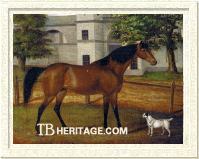
Sir Solomon
| |
SIR SOLOMON (1796, originally called Tankersley) was a bay out of the Florizel daughter, Matron (not the same Matron that produced Sir Harry), who also bred a sister to Sir Solomon, MINSTREL (1803). Minstrel's branch of Family 24 was successful with such tail-female descendants as The Baron (1842, St. Leger), Irish classic winners Maid of Athens and Kyrle Daly, Grand National Steeplechase winner Jenkinstown, and French Classic winers Wirthschaft and Beauvais.
|
Sir Solomon was not a promising racehorse at age three, unplaced in four races, including the St. Leger. With a change of ownership and name, and a year more under his belt, he emerged as a good distance horse. He won two races at Nottingham and the four mile King's Plate at York, and was unplaced three times. At age five he emerged as one of the top four-milers of his generation: he won the Stand Plate, beating the good Chance and others; the King's Plate at Newcastle over three miles; the Newcastle Cup, beating AGONISTES, the Nottingham Cup, beating the good horse Cinnamon, and an exciting match against the 1799 St. Leger winner, Cockfighter at Doncaster. In his only other race that year, he ran second to Chance in the Doncaster Cup, giving away weight to him. In 1802 he won the Newcastle Cup, a four mile race at York, the Great Subscription Purse at York, beating Cockfighter, his only opponent, and races at Lincolnand Canterbury. He ran second once, to Chance, in a sweepstakes at Malton, and third once, in the Doncater Cup (won by Alonzo).
He was not a particularly successful sire, but he did get some good producing daughters. Henrietta (1807) was the dam of St. Leger winner Tarrare (1823), and Derby winner Musjid (1856) was a descendant of one of her daughters. Remembrance (1805, Family 9 - b), a half-sister to St. Leger winner Remembrancer, was a tail-female ancestress of some important horses, including Derby winner Daniel O'Rourke, the important stallion Dark Ronald, a number of German and French classic winners, and American runners Upset, Hill Prince, Greek Song, Silent Screen, Peter Quince, Cicada, First Landing, and the recently deceased stallion Cherokee Colony. Another, unnamed daughter (1805) was tail-female ancestress of French class winners Vendredi, Nativa, Nancy, Nat, and Dorade. The American-born winner of the Grand National Steeplechase, Rubio (1898) was a descendant of another Sir Solomon daughter (1808).
SIR PAUL (1802) was out of the great distance running mare and St. Leger winner Pewet, by Tandem. Pewet was also an outstanding broodmare, dam of Woodpecker (by Buzzard); the good running filly Lapwing (1797); the in-bred Clinkerina (1812, by CLINKER, a son of Sir Peter), dam of the good running Whisker daughter Ringlet, and of Humphrey Clinker (1822, by Comus) who got the important sire Melbourne; and Sir Paul's sister, St. Leger winner PAULINA (1804). Through her daughters Paulina established a successful branch of Family 8. Sir Paul was a stout distance runner; he placed third in the 1805 St. Leger to Staveley and CALEM QUOTEM and third in the Doncaster Cup. He got Doncaster Cup winner Otho (1815) and Paulowitz (1813), who got a Two Thousand Guineas winner (Archibald), and the sire line continued through Paulowitz through the beginning of the 20th century, with the handsome Wild Dayrell,/a> (1852) and his son, Buccaneer (1857) giving it new life through See Saw (1865), Formosa (1865, Oaks, 1,000 Guineas, St. Leger, dead-heated 2,000 Guineas) and Kisber (1873, Epsom Derby, Grand Prix de Paris). Grey Leg (1891) and Dinna Forget (1892) were later representatives of it.
|
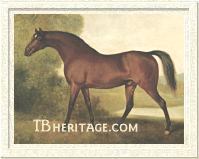
Ambrosio
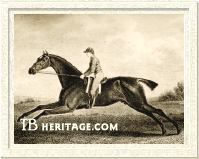
Pipylin
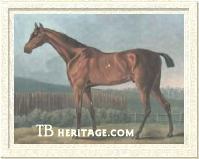
Barbarossa
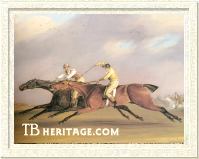
Trafalgar
| |
AMBROSIO (1793) was a big bay colt out of Tulip, by Damper, and turf observers of the early 19th century said he was the best of Sir Peter's sons, and he was certainly among them, in terms of number and quality of races won -- 18 in all. He, too was a distance horse. He won four of his five races at age three, including the St. Leger, and other races over two miles beating the cream of the three-year-old northern turf runners; his only loss that season was to the great Cup specialist Hambletonian in the Doncaster Cup. The next year he won the Newmarket Craven Oatlands, and a match against Lop, but he lost some matches and ran third in the Oatlands of Newmarket First Spring.
The next year, 1798, he won the Newmarket Craven Oatlands and the Newmarket Spring Oatlands, beating STAMFORD into second place in both those races, two sweepstakes at Newmarket and Newmarket's Jockey Club Plate, and took a walk-over for another sweepstakes there. In his only other race that season he ran third to Diamond in a sweepstakes. In his last year he won three of his five races, including the Great Subscription Purse at York. He was sent to stud in Ireland. His sister, ROXANA (1796) won a 300 guineas match against Volatile, and a 100 guineas match against Manilla, and her female line bred on through the 20th century.
PIPYLIN (1799), out of Rally, by Trumpator ran for four seasons, and in 26 starts, won 11 times, placed second 3 times and dead-heated once. He ran second to Orville in the St. Leger. Most of his races were small purse heat races and matches over two to four miles at Newmarket and Doncaster. He died early, at age eight.
BARBAROSSA (1802, out of Mulespinner by Guildford) ran for three seasons. He won the Egremont Stakes at Brighton as a three-year-old, and at age four won the King's Plate at Newmarket, the King's Plate at Lewes, and the King's Plate at Canterbury, and the Somerset Stakes at Brighton. At age five he won several races at Bibury, and retired to stud at age eight.
TRAFALGAR ( 1802), bred by Darlington from his Young Marske mare, Aethe, was a top-class runner for Lord Lowther. His wins included the first class of the Prince's Stakes at Newmarket; Brighton's Pavilion Stakes; the Egremont Stakes, beating Bronze, who had won the Oaks; the Pontefract Gold Cup; the Doncaster Stakes, beating the good mare Vesta, and on the same day he ran second in the Doncaster Gold Cup; he won 1500 guineas at York Spring in 1807, was second to Crazy in York's Great Subscription Purse, and beat Stavely in a 500 guineas match at Doncaster. He also ran second to PARIS in the Derby (1806), and in 1808 beat him in a match over the Beacon Course at Newmarket. In the stud Trafalgar was bred to Oaks winner Meteora, producing Larissa (1813), dam of Chester Cup winner Hymettus and tail-female ancestress of a number of good winners.
|
DITTO (1800), out of Arethusa, and so brother to WALTON, won the Derby in a small field of six horses. The following year he won the Claret Stakes at Newmarket, and in 1805 won Newmarket's Craven Stakes beating a good field that included Castrel, and won the King's Plate over 4 miles at Guildford. In the stud he got Luzborough (1820), who won 25 of his 36 races, which included cups, plates and stakes. Luzborough was imported into the U.S. in 1832 by Merritt & Co., and became a very successful sire; one of his sons, Picton, won the rich Dorsey Stakes at Baltimore in 1837, worth $8,400.
Sir Peter sons that made some kind of mark in the stud, other than those mentioned previously, included Derby winner ARCHDUKE (1796, out of Horatia, and so brother to STAMFORD). In England he got Roseden, who was sent to Ireland where he got the so-called "Roseden Mare," the head of the important Half-Bred Family 1. Archduke was the third of three Derby winners purchased by John Hoomes of Virginia, the first being the enormously influential Diomed, and the second Spread Eagle. Archduke arrived in the U.S. in 1803 where he stood at Hoomes' Bowling Green, after which he made the stallion breeding circuit. He did not make much of a mark as a stallion there, although Horatia, a daughter in his first crop, won the important Produce Sweepstakes at Fredricksberg in 1808; a daughter, Jenny, was the dam of a good race mare, Polly Hopkins. A daughter, Castania, from Sir Archy's dam, Castinaria, did not breed on.
Another Sir Peter son that went to the U.S. was YOUNG SIR PETER TEAZLE (1791, out of Conductor daughter, Lucy). He was also bred to Castinaria in the U.S., getting Virgo (1809), who was second dam of a Sir Charles son, the two-mile horse Havoc, a winner of the Annual Post Stake at Broad Rock, a $1,000 per side match against Collier, and other good races, later a modest sire in Tennesse and Kentucky.
Sir Peter's son ROBIN REDBREAST (1796, from Wren, and so brother to AGONISTES), ran for several seasons in secondary venues and was a minor winner; he placed second to Baron Nile in a sweepstakes at Lichfield for 260 guineas, beating Dick Andrews and several others. He was also sent to America, and there he got an unnamed daughter that had great influence on American breeding. She was the dam of Old Flirtilla (1820), an outstanding four mile winner in the north and the south, including a famous north-south match against Ariel ($30,000 a side); her daughter, Flirtilla Jr. bred on, with tail female descendants including Sun Beau, Mad Play and Mad Hatter. The Robin Redbreast daughter also produced the stallion Sumpter (1818), dam's sire of Alice Carneal, the dam of Lexington.
FYLDENER (1803) , from Fanny by Diomed, won the St. Leger and got some daughters that bred on, including an unnamed mare that produced Woodcote Stakes winner Swallow (1833, by Camel).
Three of Sir Peter's daughters won classic races.
HERMIONE (1791, from Paulina, by Florizel), was Derby's second Oaks winner. She won 21 races, most of them for J.H. Durand, who bought her in 1795, and soon after she won the Oxford Cup for him. Like other Sir Peters, she was a distance horse, running in King's Plates, the Oatlands and other races. She does not appear to have produced any foals, but her sisters, LADY JANE (1796) and HIND (1797) did. Lady Jane ran second in the Oaks of 1799, and won five races that year. She produced Briseis (1804, by Beningbrough), who won the Oaks and later produced the dual-classic winning filly Corinne (1813, by Waxy), Ascot Gold Cup winner Marcellus (1819), and Abjur (1917), whose only loss in two years on the turf was a second in the Derby. Goodwood Cup winner (twice) and influential sire Harkaway (1834) descended from Lady Jane, and Hind's female family also included French Derby winner Le Capucin (1920).
PARISOT (1793, out of Deceit, by Tandem) won the Oaks of 1796, and ran for several more years at Newmarket. She bred on for a few generations, but a more successful producer was her brown UNNAMED MARE sister (1802), dam of Gramarie by Sorcerer, who produced Derby winner Prince Leopold and a number of successful daughters that bred on: Derby winner Amato, German Derby winners Gamiani and Taurus, the great French race mare Lydia, and a number of other classic winners descend from her ( Family 2 - a).
PAULINA (1804, out of Pewet, by Tandem, and so sister to SIR PAUL), won the St. Leger and eight other races, including a Produce Stakes, the Filly Stakes at York, and a King's Plate. She has her own branch of Family 8 (8-e) sent forward through two daughters, Camilla and Galatea. A great many stakes winners descend from Galatea, including Dual classic winner Sir Tatton Sykes (1843), Derby winner Andover (1951), and many other stakes winners in countries around the world.
Some of Sir Peter's other daughters were good runners, or good producers.
BEATRICE (1791) was bred by William Fenwick in Northumberland and sold, in foal to Pipator; she dropped her filly, Vicissitude (in-bred 4 x 3 to Matchem) at the Streatlam stud in 1800. When the expenses of keeping her went unpaid by her new owner, and eventually exceeded that of her worth, the Earl of Strathmore took her and the filly in lieu of payment. Beatrice would breed twelve additional foals for Strathmore, including the good runners Runnemede (1806, by Coriander) and Heart of Oak (1811, by Remembrancer). Vicissitude produced the great broodmare Gibside Fairy, who won a race for juveniles at Catterick; she is the font from which most of Family 7 springs, particularly through her great daughter, Emma.
|
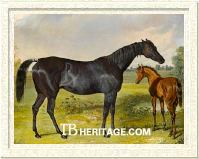
Pipylina
| |
PIPYLINA (1803), out of Rally, and so sister to PIPYLIN, had a modest career on the turf for her owner, Lord Foley. Her daughter, Young Pipylina (1822, by Orville), produced July Stakes winner Forester. A second daughter, by Selim (1812), continued her tail-female line, which included a branch of winners in Poland, and Epsom Derby winner Plenipotentiary and The Fallow Buck.
MARY ANN (1791, from a Young Marske mare) was a winner, and at age five ran second to the great race mare Eliza in a King's Plate over 4 miles at York. In the stud she produced Oaks winner Oriana (1807, by Beningbrough), and her brother, the good runner Ashton (1799). Her female line continued ( Family 18-a), and included Colorado King (1959) an important racehorse in South Africa. A sister to Mary Ann, MONICA (1792) also bred on.
|
CECILIA (1793, was a half-sister to Pewet, the dam of SIR PAUL and PAULINA). She won at Chesterfield, beating the good runner and later sire Jupiter. In the stud she produced Doncaster Cup winner Whitenose (1806, by Don Quixote).
Sir Peter got four producing daughters and a son, CALEB QUOTEM (1802) from a Diomed mare (1788, Family 5 - a). Caleb Quotem won the Doncaster Cup and was second in the St. Leger. His sister, MARY (1803), became the dam of the dual-classic winning filly Neva (1814, by Cervantes), and her family bred on with good winners until the mid-19th century.Another sister, FANNY (1796) produced Desdemona (1811, by Orville) who became the dam of the Doncaster Cup winner and sire Mulatto, and Fanny became the tail-female ancestress of many good winners through both Desdemona and Ursula (1818).
HOUGHTON LASS (1801, from Alexina by King Fergus) was a good runner over several seasons, placing second to Alaric in Newmarket's Oatlands handicap stakes at age three, and running second in that race again at age six, and second to Walton in the Somerset Stakes at Brighton; she beat a great many good horses during her time on the turf. In the stud she produced Comus (by Sorcerer), a fair race horse,who got four classic winners and Humphrey Clinker, through which the Godolphin Arabian sire line descended. Houghton Lass's sister, EPSOM LASS (1803), a winner of Royal Plates and other races, was second dam of a leading sire in England, Slane, and established a long-lived female family that included a great many top French racehorses, and winners in South America. Another sister, ZAIDA (1806), produced Oaks winner Zeal (1818) and Oaks and One Thousand Guineas winner Zinc; both these daughters and a sister to Zeal, Zafra, bred on ( Family 25).
MARGARETTA (1802, from a Highflyer mare) produced Goodwood Cup winner Scarecrow (1813, by Canopus) and Waverley (1817, by Whalebone), the latter a winner in north country races, including the Newcastle Cup and the Pontefract Cup. He became an influential sire of such horses as Doncaster Cup and York St. Leger winner The Saddler (1828, later a sire of a classic winner); Sylvan (Manchester Cup), The Provost, a very good stakes and cup winner in the north; the long-running four-mile mare, Inheritress (established a family of winners in France and Germany); and Doncaster Cup and St. Leger winner Don John, later a good sire of winners and producers and grandsire of Bonnie Scotland, so influential in the U.S.
It's hard to overestimate Sir Peter's influence on the breed through his many successful sons and daughters, a dominant force on the turf at the turn of the century and in the breeding shed for many years after. He died on August 18, 1811, his grave marked at Knowlsey by a plain flat stone inscribed with the words, "Sir Peter."
--Patricia Erigero
|
|
|
|

